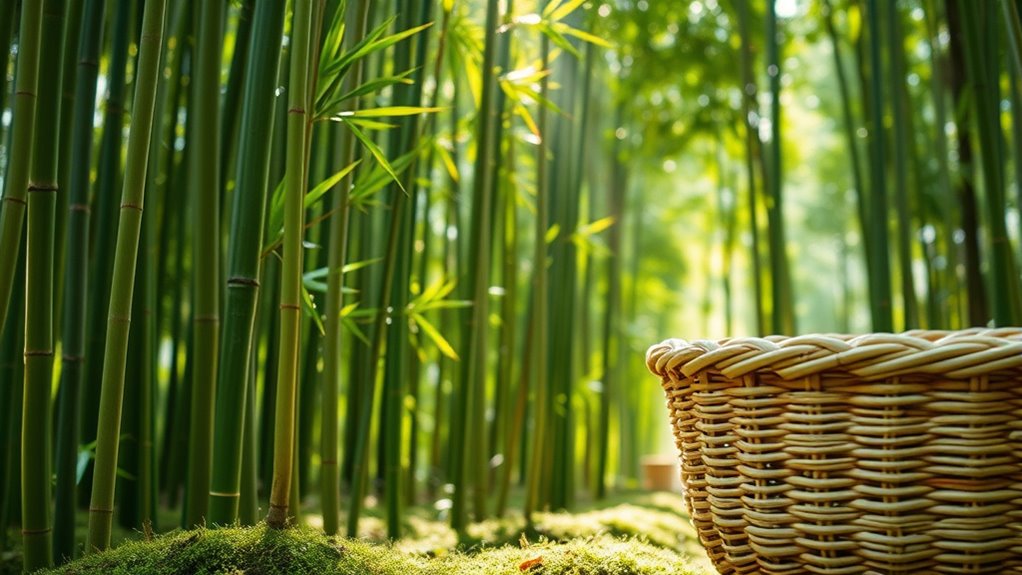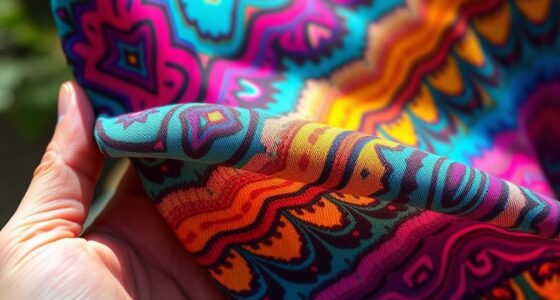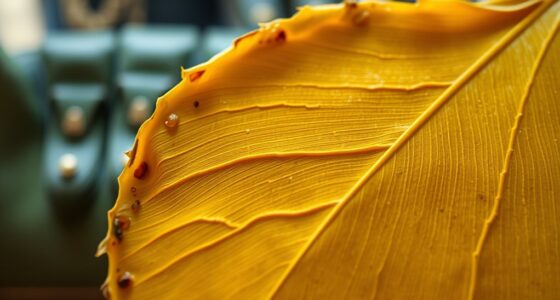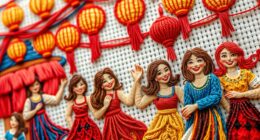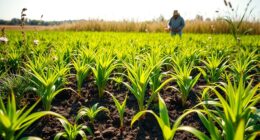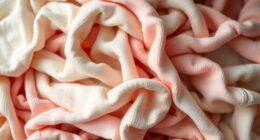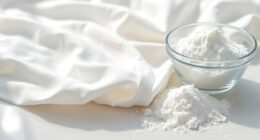Bamboo fabric is often seen as eco-friendly because bamboo grows quickly, needs little water, and doesn’t require pesticides. However, most bamboo textiles are made through chemical-intensive processes like viscose production, which can release toxic substances and harm the environment. The overall sustainability depends on how the fabric is produced, with some brands using safer methods. To truly understand its eco impact, it’s helpful to explore how manufacturing choices influence sustainability. Keep exploring to discover the full picture.
Key Takeaways
- Bamboo’s rapid growth makes it a renewable resource, but environmental benefits depend on sustainable cultivation practices.
- Most bamboo fabric is produced via chemical-intensive viscose processes that can harm the environment if not properly managed.
- Eco-friendliness varies; closed-loop manufacturing systems that recycle chemicals reduce environmental impact.
- Responsible sourcing and transparency from brands are crucial to ensure bamboo fabric’s sustainability claims.
- Alternatives like lyocell or modal are less harmful but are less commonly used in commercial bamboo textiles.
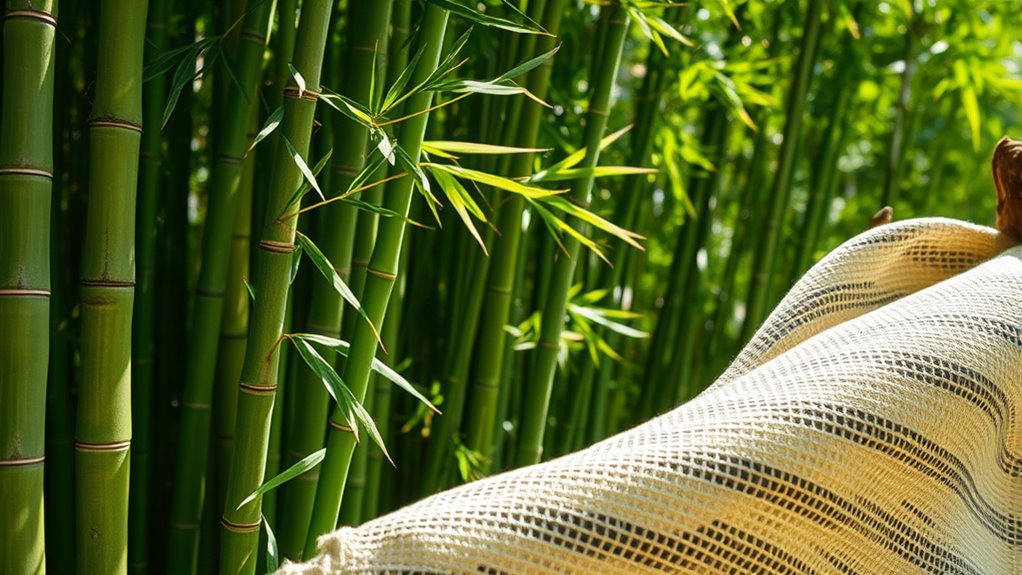
Is bamboo fabric truly a sustainable choice? When you look into it, the answer isn’t as straightforward as you might hope. Bamboo is often praised as an eco-friendly resource because it grows quickly and requires minimal water. However, the environmental impact of bamboo fabric heavily depends on the manufacturing processes involved. If you’re trying to make eco-conscious choices, it’s important to understand what happens behind the scenes. The initial appeal of bamboo lies in its rapid growth and natural ability to thrive without pesticides or fertilizers. These qualities suggest that harvesting bamboo could be less damaging than traditional cotton or synthetic fibers. But once you move beyond cultivation, things get more complicated. The process to turn raw bamboo into soft fabric involves several steps, some of which can be quite harmful to the environment.
Most commercial bamboo fabric is made through a chemical-intensive process called viscose or rayon production. During this process, bamboo pulp is dissolved using harsh chemicals like carbon disulfide, which can be toxic if not managed properly. These chemicals are essential to break down the bamboo into a viscous solution that can be spun into fibers. Unfortunately, they often end up in water systems, posing risks to aquatic life and local communities. While some manufacturers are adopting more eco-friendly methods, such as lyocell or modal processes that use less harmful solvents, these alternatives are not yet widespread. As a consumer, you need to be aware that not all bamboo fabrics are created equal in terms of environmental impact.
The sustainability of bamboo fabric hinges on the manufacturing processes used. If the process relies heavily on toxic chemicals and generates significant waste, then the fabric’s eco-friendly reputation diminishes. Conversely, if producers utilize closed-loop systems that recycle chemicals and minimize pollution, then bamboo fabric can be a more sustainable option. It’s also worth considering whether the bamboo is sourced responsibly—harvesting from sustainable plantations rather than deforestation can make a big difference. Additionally, some brands are committed to transparency, providing details about their production methods and environmental practices.
Frequently Asked Questions
How Does Bamboo Fabric Compare to Organic Cotton in Sustainability?
Bamboo fabric is generally more sustainable than organic cotton because bamboo cultivation requires less water and no pesticides, making it eco-friendly. Organic cotton farming, while also eco-conscious, uses more water and land. You’ll find bamboo grows quickly and regenerates naturally, reducing environmental impact. In contrast, organic cotton needs careful management, but both options are better than conventional fabrics. Overall, bamboo fabric often has a smaller ecological footprint.
Are There Any Harmful Chemicals Used in Processing Bamboo Fabric?
You’ll be surprised to learn that about 50% of bamboo fabric is made through chemical processing, which can involve harmful toxins. These chemicals, like sodium hydroxide and solvents, are used to turn bamboo into soft fabric, raising toxin concerns. While some manufacturers use eco-friendly processes, it is crucial to check labels. So, yes, harmful chemicals can be involved, but sustainable options are increasingly available to reduce environmental impact.
What Is the Environmental Impact of Bamboo Cultivation?
You should know that bamboo cultivation impacts the environment through large bamboo plantations, which can lead to soil erosion if not managed properly. While bamboo grows rapidly and requires less water and pesticides, expanding plantations without sustainable practices can harm local ecosystems. To minimize environmental harm, choose products from responsibly managed bamboo sources that prioritize soil conservation and avoid excessive land clearing.
Can Bamboo Fabric Be Recycled or Composted?
You might think bamboo fabric can’t be recycled or composted, but it actually depends on its processing. If it’s mechanically processed, it can often be composted, returning nutrients to the soil. However, if chemically treated, recycling options are limited, and composting feasibility drops due to chemical residues. Always check the fabric’s care label or manufacturer info to determine whether your bamboo textiles can be responsibly recycled or composted, reducing environmental impact.
How Does the Durability of Bamboo Fabric Affect Its Sustainability?
You’ll find that bamboo fabric’s durability positively impacts its environmental benefits and long-term sustainability. Its strong fibers mean the fabric lasts longer, reducing the need for frequent replacements. When you choose durable bamboo items, you support a more sustainable cycle, lowering waste and conserving resources. This longevity helps guarantee bamboo remains an eco-friendly option, contributing to a reduced environmental footprint and promoting a more sustainable future for textile production.
Conclusion
So, when you consider bamboo fabric’s eco claims, remember it’s not all fairy tales and unicorns. While it’s quick-growing and biodegradable, the processing can sometimes be harsh, like a medieval alchemist’s lab. To truly be sustainable, look for brands that prioritize eco-friendly methods, ensuring bamboo remains a hero in your wardrobe. After all, in this age of innovation, choosing responsibly now can save our planet for future generations—no time machine needed.

